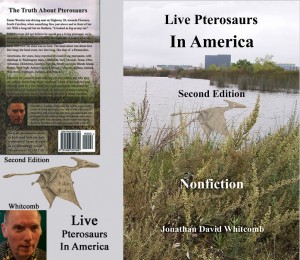Last August, I wrote the post “Frigate Birds are not Pterosaurs.” It briefly explained why some commenters were mistaken about a Youtube video of a Frigate bird. The subject, the possibility that eyewitnesses have actually seen those sea birds instead of pterosaurs, deserves more attention.
On The Bible and Modern Pterosaurs, the February 23, 2011, post gives more details about the Frigate bird, in particular on how the misidentification possibility relates to the 1944 sighting by Duane Hodgkinson. That American saw a giant featherless flying creature that could not have been a Frigate bird.
Two army buddies were standing at one side of a jungle clearing (1944, west of Finschhafen, New Guinea); a large creature flew up from the ground of the other side of that clearing. The soldiers had a perfectly clear view of the “pterodactyl,” as it ran to their left and took off into the air. Hodgkinson still remembers how the vegetation swayed from the wing flapping. How critical is the size of that clearing! At about one hundred feet in diameter, that field was small enough to prevent any major distortion in estimating the size of the flying creature. An estimate of twenty-seven feet for the wingspan makes it impossible for it to have been a Frigate bird in masquerade.
The Frigate Bird and Pterosaur Sightings in Papua New Guinea
Duane Hodgkinson’s 1944 sighting leads us into other sightings of apparent pterosaurs in Papua New Guinea. Could this World War II veteran’s encounter be an exception? Could the Frigate-bird-explanation answer most other sightings? Actually, no. One problem relates to pterosaur bioluminescence: Frigate birds do not glow at night. Another problem relates to grave robbery: Frigate birds do not rob human graves, carrying off the body of an adult human. And then there are the reports of live adult humans being carried away by giant flying creatures: not likely Frigate birds.
Frigate Birds and Living Pterosaurs in General
How are some critical sightings evidence of a live pterosaur, rather than a misidentified bird? Consider the 1971 Cuba sighting by Eskin Kuhn. Look at his sketch of the pterosaur with wings down, about to begin an upbeat-cycle of wing-flapping. Notice the legs, separate from the long tail. Also notice the large head crest at the back of the creature’s head. How obvious that this is not a sketch of a Frigate bird!
Consider the 2007 San Joaquin Wildlife Sanctuary pterosaur sighting of a long-tailed flying creature with no feathers and with a total length of about thirty feet. (The length-estimate was no wild guess, for the apparent-ropen flew just above the road; I later measured the width of that road, the approximate length of the ropen: thirty feet) In addition, the wrinkles on the underside of the wings indicated the giant flying creature had no feathers.
Consider also the worldwide sightings of glowing pterosaurs flying at night: those are not Frigate birds.



